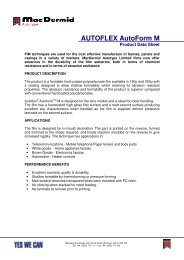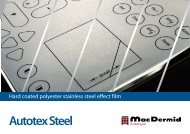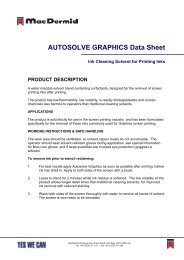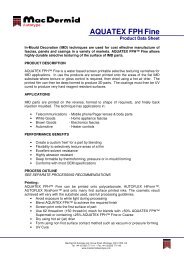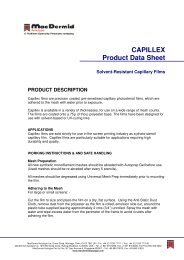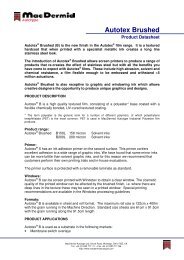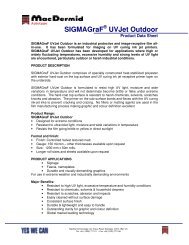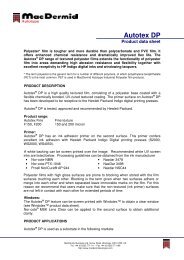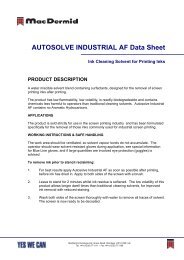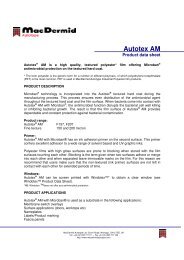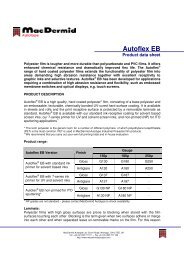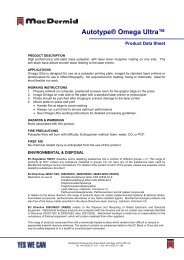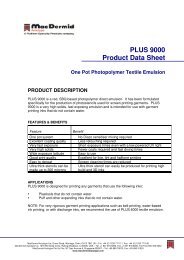Screen E-Book (.PDF) - MacDermid Autotype
Screen E-Book (.PDF) - MacDermid Autotype
Screen E-Book (.PDF) - MacDermid Autotype
- No tags were found...
You also want an ePaper? Increase the reach of your titles
YUMPU automatically turns print PDFs into web optimized ePapers that Google loves.
grid) in a conventional set that was printedon the same sheet. How could dots give alined moiré? They should give a grid pattern.Close examination showed that thedots were elliptical. This provided sufficientasymmetry to bring out the moiré inone particular direction. In both cases, themoiré was amplified by skipping.Other aspects of the 3D nature of screenprinting can introduce asymmetries thatcan also amplify the moiré. Once again it isthese subtleties that can make moiré sucha frustrating will-o’-the-wisp.In my opinion, backed up by looking atcountless moirés on a wide variety ofprints, 15° moiré becomes a significantproblem only when you have skipping orspreading. So the only way to reduce it isto reduce skipping or spreading. And, aswe’ve shown in recent articles, the only effectiveway to reduce them (other than usingexpensive planarising layers) is to printa smaller dot. And the only ways to print asmaller dot are:1.- use solvent-based inks or water-basedUV2.- use a thinner mesh3.- go to a low EOM stencil with a low Rz,which means in turn that you have to goto a modern film stencil material.Note that 2 and 3 above also help reducemesh moiré. Thinner mesh and a betterstencil reduce two types of moiré. It’s nicethat the laws of physics are on our side.Recognition of this dot-on-dot effect is, ofcourse, not new. Coudray pointed it out inhis article. The crucial new point is that themechanism behind it is better understoodas is the understanding of the only way(smaller dots) to reduce it.Is that really the only way? At the systematiclevel, yes. But if you are willing to playvarious games you might reduce it via othermeans. First, you can swap around the15° colour in the hope that in your particularprint it won’t be too visible – the humaneye is less sensitive to some colours thanto others. Second, you can try printing the15° colour as the 4th colour on top of theprevious rosettes. With luck those rosetteswill have sufficiently planarised the substratethat the dot-on-dot effects will beminimised. Good luck if you try these. Andsometimes this is the only thing you can do.But what we’re trying to do in this industryis stop the constant messing around fromjob to job. So do whatever you can to printsmaller dots in the first place and the amplificationof the 15° moiré will be reducedat a fundamental level.There’s one other factor that can affectthe visibility of the 15° moiré. If you usea round dot then the amplitude of themoiré is equal in two directions. If you usea highly elliptical, rhomboid (diamond) orgeometrical halftone then, as mentionedabove, the amplitude is concentrated inone direction and you see a line ratherthan a grid pattern. By concentrating the116



